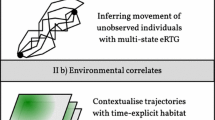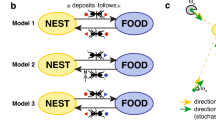Abstract
Modeling complex collective animal movement presents distinct challenges. In particular, modeling the interactions between animals and the nonlinear behaviors associated with these interactions, while accounting for uncertainty in data, model, and parameters, requires a flexible modeling framework. To address these challenges, we propose a general hierarchical framework for modeling collective movement behavior with multiple stages. Each of these stages can be thought of as processes that are flexible enough to model a variety of complex behaviors. For example, self-propelled particle (SPP) models (e.g., Vicsek et al. in Phys Rev Lett 75:1226–1229, 1995) represent collective behavior and are often applied in the physics and biology literature. To date, the study and application of these models has almost exclusively focused on simulation studies, with less attention given to rigorously quantifying the uncertainty. Here, we demonstrate our general framework with a hierarchical version of the SPP model applied to collective animal movement. This structure allows us to make inference on potential covariates (e.g., habitat) that describe the behavior of agents and rigorously quantify uncertainty. Further, this framework allows for the discrete time prediction of animal locations in the presence of missing observations. Due to the computational challenges associated with the proposed model, we develop an approximate Bayesian computation algorithm for estimation. We illustrate the hierarchical SPP methodology with a simulation study and by modeling the movement of guppies.
Supplementary materials accompanying this paper appear online.



Similar content being viewed by others
References
Aeschbacher, S., Beaumont, M. A., and Futschik, A. (2012), “A novel approach for choosing summary statistics in approximate Bayesian computation,” Genetics, 192, 1027–1047.
Beaumont, M. A. et al. (2010), “Approximate Bayesian computation in evolution and ecology,” Annual Review of Ecology, Evolution and Systematics, 41.
Berliner, L. M. (1996), “Hierarchical Bayesian time series models,” in Maximum entropy and Bayesian methods, Springer, vol. 79, pp. 15–22.
Bode, N. W., Franks, D. W., Wood, A. J., Piercy, J. J., Croft, D. P., and Codling, E. A. (2012), “Distinguishing social from nonsocial navigation in moving animal groups,” The American Naturalist, 179, 621–632.
Bonnell, T. R., Henzi, S. P., and Barrett, L. (2016), “Direction matching for sparse movement data sets: determining interaction rules in social groups,” Behavioral Ecology.
Cressie, N. and Wikle, C. (2011), Statistics for Spatio-Temporal Data, New York: John Wiley & Sons.
Dalziel, B. D., Corre, M. L., Côté, S. D., and Ellner, S. P. (2016), “Detecting collective behaviour in animal relocation data, with application to migrating caribou,” Methods in Ecology and Evolution, 7, 30–41.
Drovandi, C. C., Pettitt, A. N., and Lee, A. (2015), “Bayesian indirect inference using a parametric auxiliary model,” Statistical Science, 30, 72–95.
Ehrlich, E., Jasra, A., and Kantas, N. (2015), “Gradient free parameter estimation for hidden Markov models with intractable likelihoods,” Methodology and Computing in Applied Probability, 17, 315–349.
Fasiolo, M., Pya, N., Wood, S. N., et al. (2016), “A Comparison of Inferential Methods for Highly Nonlinear State Space Models in Ecology and Epidemiology,” Statistical Science, 31, 96–118.
Fearnhead, P. and Prangle, D. (2012), “Constructing summary statistics for approximate Bayesian computation: semi-automatic approximate Bayesian computation,” Journal of the Royal Statistical Society: Series B (Statistical Methodology), 74, 419–474.
Frair, J. L., Nielsen, S. E., Merrill, E. H., Lele, S. R., Boyce, M. S., Munro, R. H., Stenhouse, G. B., and Beyer, H. L. (2004), “Removing GPS collar bias in habitat selection studies,” Journal of Applied Ecology, 41, 201–212.
Gautrais, J., Jost, C., and Theraulaz, G. (2008), “Key behavioural factors in a self-organised fish school model,” in Annales Zoologici Fennici, pp. 415–428.
Hooten, M., Johnson, D., McClintock, B., and Morales, J. (2017), Animal Movement: Statistical Models for Telemetry Data, Chapman & Hall/CRC Boca Raton, Florida, USA.
Hooten, M. B. and Wikle, C. K. (2010), “Statistical agent-based models for discrete spatio-temporal systems,” Journal of the American Statistical Association, 105, 236–248.
Hubbard, S., Babak, P., Sigurdsson, S. T., and Magnússon, K. G. (2004), “A model of the formation of fish schools and migrations of fish,” Ecological Modelling, 174, 359–374.
Lagarrigues, G., Jabot, F., Lafond, V., and Courbaud, B. (2015), “Approximate Bayesian computation to recalibrate individual-based models with population data: illustration with a forest simulation model,” Ecological Modelling, 306, 278–286.
Langrock, R., Hopcraft, J. G. C., Blackwell, P. G., Goodall, V., King, R., Niu, M., Patterson, T. A., Pedersen, M. W., Skarin, A., and Schick, R. S. (2014), “Modelling group dynamic animal movement,” Methods in Ecology and Evolution, 5, 190–199.
Mann, R. P. (2011), “Bayesian inference for identifying interaction rules in moving animal groups,” PLoS One, 6.
Marin, J.-M., Pudlo, P., Robert, C. P., and Ryder, R. J. (2012), “Approximate Bayesian computational methods,” Statistics and Computing, 22, 1167–1180.
Marjoram, P., Molitor, J., Plagnol, V., and Tavaré, S. (2003), “Markov chain Monte Carlo without likelihoods,” Proceedings of the National Academy of Sciences, 100, 15324–15328.
Martin, G. M., McCabe, B. P., Frazier, D. T., Maneesoonthorn, W., and Robert, C. P. (2016), “Auxiliary Likelihood-Based Approximate Bayesian Computation in State Space Models,” arXiv preprint arXiv:1604.07949.
McClintock, B. T., Johnson, D. S., Hooten, M. B., Ver Hoef, J. M., and Morales, J. M. (2014), “When to be discrete: the importance of time formulation in understanding animal movement,” Movement Ecology, 2.
Millspaugh, J., Kesler, D., Kays, R., Gitzen, R., Schulz, J., Rota, C., Bodinof, C., Belant, J., and Keller, B. (2012), “Wildlife radiotelemetry and remote monitoring,” The Wildlife Techniques Manual, 1, 258–283.
Nott, D. J., Marshall, L., and Ngoc, T. M. (2012), “The ensemble Kalman filter is an ABC algorithm,” Statistics and Computing, 22, 1273–1276.
Pereyra, M., Dobigeon, N., Batatia, H., and Tourneret, J.-Y. (2013), “Estimating the granularity coefficient of a Potts-Markov random field within a Markov chain Monte Carlo algorithm,” IEEE Transactions on Image Processing, 22, 2385–2397.
Perna, A., Grégoire, G., and Mann, R. P. (2014), “On the duality between interaction responses and mutual positions in flocking and schooling,” Movement Ecology, 2.
Picchini, U. (2014), “Inference for SDE models via approximate Bayesian computation,” Journal of Computational and Graphical Statistics, 23, 1080–1100.
Picchini, U. and Forman, J. L. (2016), “Accelerating inference for diffusions observed with measurement error and large sample sizes using approximate Bayesian computation,” Journal of Statistical Computation and Simulation, 86, 195–213.
Russell, J. C., Hanks, E. M., and Haran, M. (2016), “Dynamic Models of Animal Movement with Spatial Point Process Interactions,” Journal of Agricultural, Biological, and Environmental Statistics, 21, 22–40.
Scharf, H. R., Hooten, M. B., Fosdick, B. K., Johnson, D. S., London, J. M., and Durban, J. W. (2017), “Dynamic social networks based on movement,” The Annals of Applied Statistics, 10, 2182–2202.
Sisson, S. and Fan, Y. (2011), “Likelihood-free MCMC,” Handbook of Markov Chain Monte Carlo, 313–335.
Tavaré, S., Balding, D. J., Griffiths, R. C., and Donnelly, P. (1997), “Inferring coalescence times from DNA sequence data,” Genetics, 145, 505–518.
Van der Putten, W. H., Macel, M., and Visser, M. E. (2010), “Predicting species distribution and abundance responses to climate change: why it is essential to include biotic interactions across trophic levels,” Philosophical Transactions of the Royal Society B: Biological Sciences, 365, 2025–2034.
Vicsek, T., Czirók, A., Ben-Jacob, E., Cohen, I., and Shochet, O. (1995), “Novel type of phase transition in a system of self-driven particles,” Physical review letters, 75:1226–1229
Wolfram, S. (1983), “Statistical mechanics of cellular automata,” Reviews of modern physics, 55, 601.
Yates, C. A., Baker, R. E., Erban, R., and Maini, P. K. (2010), “Refining self-propelled particle models for collective behaviour,” Canadian Applied Mathematics Quarterly, 18, 299–350.
Author information
Authors and Affiliations
Corresponding author
Electronic supplementary material
Below is the link to the electronic supplementary material.
Appendices
Appendix A: Full HiSPP Process Model Equation
The process model (i.e., Eq. 5) from Sect. 4.2 contains various update rules based on the values of the updated locations. In particular, if one or both of the updated x and y locations are outside the boundary of interest, then separate update conditions are invoked. These separate update conditions ensure that the updated locations are within the boundary of interest. We use reflective conditions to push the agents back toward the region of interest. The direction in which the agents reflect back into the region of interest is estimated for the cases where an agent’s updated location is beyond the x or y boundary. If an agent’s updated location is outside both the x and y boundary, then the reflective angle is set to a fixed value (this scenario was not common for our application). Recall that the latent locations, \(\mathbf {s}_{i,t}\), are confined to a bounded region such that \(\tilde{x}_{i,t} \in [0,x_{m}]\) and \(\tilde{y}_{i,t} \in [0,y_{m}]\). The full process model is then given by the following:
Appendix B: Specification of Priors
Listed below are all of the prior distributions and corresponding hyperparameter values for the HiSPP model from Sect. 4.2.
\(\sigma _\epsilon ^2\sim \text {IG}(\alpha _\epsilon ,\beta _\epsilon )\), where \(\alpha _\epsilon =.001\) and \(\beta _\epsilon =.001\). | |
\(\sigma _\eta ^2\sim \text {IG}(\alpha _\eta ,\beta _\eta )\), where \(\alpha _\eta =4.25\) and \(\beta _\eta =24.375\). | |
\(r \sim \text {TN}_{[0,r_{\text {max}}]}(\mu _r,\sigma ^2_r) \), where \(\mu _r=\)0, \(\sigma ^2_r=100000\), and \(r_{\text {max}}=378.4\). | |
\(\beta _0\sim \text {Gau}(\mu _\beta ,\sigma ^2_\beta )\) and \(\beta _1\sim \text {Gau}(\mu _\beta ,\sigma ^2_\beta )\), where \(\mu _\beta =0\) and \(\sigma ^2_\beta =1000\). |
\(\lambda _1\sim \text {Gau}(\mu _\lambda ,\sigma ^2_\lambda )\) and \(\lambda _2\sim \text {Gau}(\mu _\lambda ,\sigma ^2_\lambda )\), where \(\mu _\lambda =0\) and \(\sigma ^2_\lambda =1000\). | |
\(x_B\sim \text {U}(a_x,b_x)\), where \(a_x=0\) and \(b_x=\frac{\pi }{2}\). | |
\(y_B\sim \text {U}(a_y,b_y)\), where \(a_y=\frac{\pi }{2}\) and \(b_y=\pi \). | |
\(\tau \sim \text {U}(a_\tau ,b_\tau )\), where \(a_\tau =0\) and \(b_\tau =.75\). | |
\(\rho \sim \text {U}(a_\rho ,b_\rho )\), where \(a_\rho =0\) and \(b_\rho =6\). |
Since many of the hyperparameters above are utilized at the bottom of the hierarchical model, they are given relatively uninformative prior distributions. The hyperparameters for the boundary conditions (i.e., \(x_B\) and \(y_B\)) were selected such that agents would always be reflected back into the region of interest. See supplementary materials (S.5) for a further discussion on the priors used with the HiSPP model.
Rights and permissions
About this article
Cite this article
McDermott, P.L., Wikle, C.K. & Millspaugh, J. Hierarchical Nonlinear Spatio-temporal Agent-Based Models for Collective Animal Movement. JABES 22, 294–312 (2017). https://doi.org/10.1007/s13253-017-0289-2
Received:
Accepted:
Published:
Issue Date:
DOI: https://doi.org/10.1007/s13253-017-0289-2




